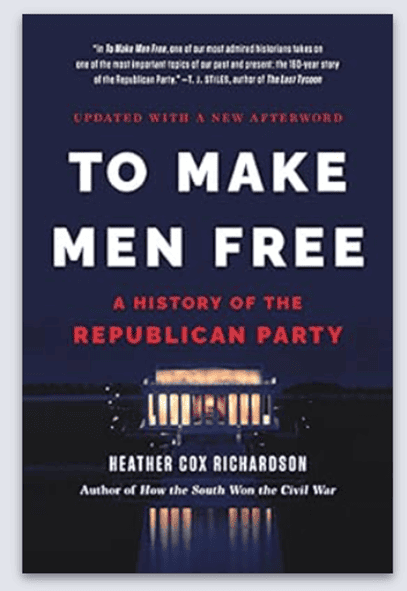By Jim Heffernan
I am a sucker for history and Heather Cox Richardson is a favorite of mine. She is a history professor at Boston University and the author of 7 books. This is her fifth book. She also writes a delightful daily column, “Letters from America”.
I found her history of the Republican party fascinating. I never quite realized the cyclic nature of the party until her book. Since the 1850’s, the Republican party has been defined by a struggle between equality and property.
Lincoln, Theodore Rosevelt, and Eisenhower fully embraced the goal of equality. Other Republican presidents have consistently favored property.
There’s a lot of history to unwrap in this book. Luckily, she writes in a light style that is very readable. She’s a dedicated teacher who does not try to impress. Her words are carefully crafted to convey clarity and understanding. Her book taught me a lot about the economic underpinnings of the civil war and it was probably the first place I was exposed to the term “movement conservatism.” The bulk of the book was written in 2014. I would highly recommend finding a version that includes her 2021 update.
Here’s an excerpt from Page 342 that I believe showcases her writing and effectively summarizes the flow of the book.
The seemingly endless circles of the Republican Party reflect the unresolved tension between equality and property in America. The Declaration of Independence established the nation on the principle that all men were created equal, and it seemed to promise equality of opportunity to all based on equal access to resources and equal treatment under law. Then the Constitution established that the nation was also based on the protection of property. These two principles, both central to America’s identity, came into conflict almost immediately when the Founding Fathers neglected to guard against the power of wealthy men to swing government policies in their own favor. The Republican Party’s founders set out to rectify this oversight, only to be caught by it themselves.
Is it possible for the party to resolve this tension? Can the future be different? Surely the party’s argument that economic opportunity for everyone must be advanced by an active government, the idea conceived by Lincoln and adopted by Theodore Roosevelt and Eisenhower, would adapt as easily to the modem global economy as it did to industrialization and to the nuclear world. But can the party shed the opposing argument, developed in the racial and political conflict of the late nineteenth century and recycled ever since, that government activism is socialism?
With today’s shift in demographics, bringing an influx of young people, immigrants, and minorities to the voting population, perhaps the cycle will finally be broken. These voters are too young to remember the Cold War and are comfortable across racial and ethnic lines, making it harder to rally them with the specters of communism or racial conflict. With the power of James Henry Hammond’s mudsill argument* weakened, party leaders may be able to turn to the question left unanswered since the framing of the Constitution: how can America promote individual prosperity without creating a powerful wealthy faction that controls the government? Forced to adapt to a changing nation, in this century, perhaps, the Republican Party will find a way to stay committed to the ideals of its founders.
*This references a concept introduced on page 14. In 1858, Hammond declared in the Senate that a proper economy was built on “mudsills”, the drudges of society who were fit only for manual labor and who should have no part in their government.
As always, discussion welcome at codger817@gmail.com
418 Pages (74 pages notes, index) Published 9/23/2014, 2021 update
Available Cloud and Leaf Bookstore, Manzanita andTillamook Public Library


